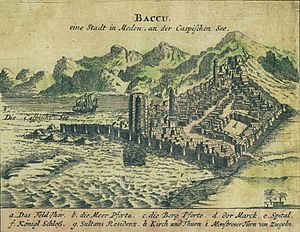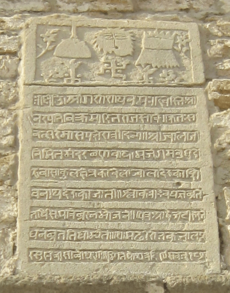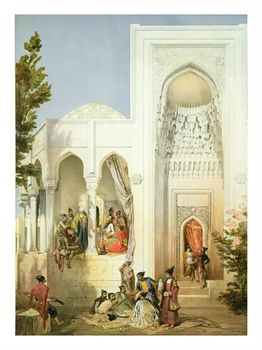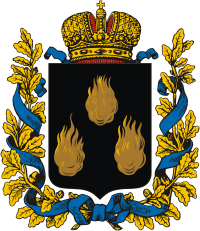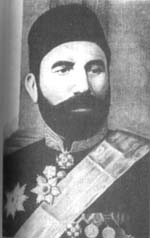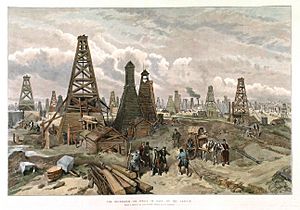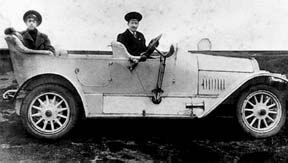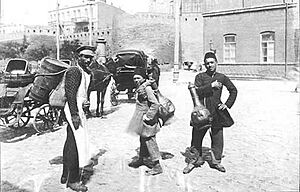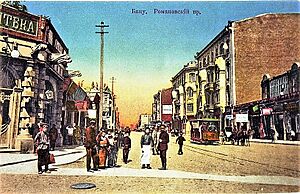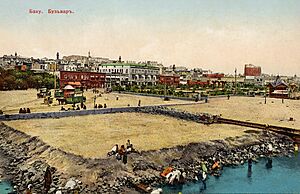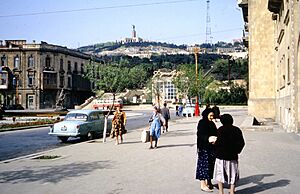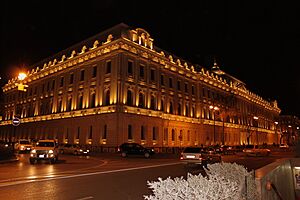History of Baku facts for kids
Baku is the capital city of Azerbaijan Republic. It has been an important capital many times throughout history. For example, it was the capital of the Shirvan kingdom, the Baku Khanate, the Azerbaijan Democratic Republic, and the Azerbaijan SSR. It was also a key administrative center during the Russian Empire era.
The name Baku comes from an old Persian word, Bagavan, which means "City of God". Some people think the name comes from Bādkube, meaning "city where the wind blows," because Baku is often windy. However, the name Bādkube appeared much later, in the 16th or 17th century, while Baku was founded long before the 5th century AD.
Contents
How Baku Got Its Name
Different names for Baku have appeared in old writings. For example, in the 5th to 8th centuries AD, it was called Atli-Bagavan or Ateshi-Bagavan. Later, in the 900s AD, it was known as Bakuh or Bakuya. By the 12th century, the name Baku became more common.
From the 13th century onwards, European writers also started mentioning Baku. They spelled its name in various ways, like Vahcüh or Bakhow. Even on old coins made by the Shirvanshah rulers, the name appears as Bakuya.
Some people have suggested other ideas for the name's origin. For instance, some believe "Baku" comes from a Turkic word meaning "hill."
Baku's Early History
Long ago, the area where Baku now stands was a savanna with many plants and animals. People have lived here since the Stone Age. We know this because of rock carvings found near Bayil from the Bronze Age. A small bronze fish figure was also found in the Old City, suggesting there was a Bronze Age settlement there.
Near Nardaran, an ancient observatory called Umid Gaya was discovered. It has carvings of the sun and stars, like a very old astronomy chart. Other digs have found old settlements, temples, and statues around the city.
Around the 1st century AD, the Romans came to Baku. You can still see Roman writings from 84–96 AD near Gobustan, close to Baku. The village of Ramana in Baku's Sabunchu district is a reminder of this time.
Some historians think Baku was called Albanopolis when Caucasian Albania existed. Local stories say that the Apostle Bartholomew was martyred at the bottom of the Maiden Tower. A Christian church was later built there on the site of an older pagan temple.
A historian from the 5th century, Priscus of Panium, was the first to write about Baku's famous fires. He said, "from the maritime stone flame emerges." These natural, eternal flames made Baku an important center for Zoroastrianism, an ancient religion. The Sassanid ruler Ardashir I even ordered that an "inextinguishable fire of the god Ormazd" be kept in the city's temples.
Medieval and Early Modern Baku
Not much is known about Baku in medieval times until the 10th century. The oldest coin found in the city is an Abbasid coin from the 8th century AD. During this time, Baku was part of the Arab Caliphate and later ruled by the Shirvanshahs. They often faced attacks from the Khazars and the Rus. Shirvanshah Akhsitan I even built a navy in Baku to fight off a Rus attack in 1170.
After a big earthquake hit Shamakhy, the capital of Shirvan, the Shirvanshahs moved their court to Baku in 1191. This made Baku even more important.
Between the 12th and 14th centuries, many strong defenses were built in and around the city. The Maiden Tower, along with castles in Ramana, Nardaran, Shagan, and Mardakan, were built then. The famous Sabayel castle, located on an island in Baku Bay, was also built during this time. The city walls were rebuilt and made stronger.
A big challenge for Baku was the rising level of the Caspian Sea. Sometimes, the water would cover parts of the city. The Sabayel castle was completely submerged in the 14th century, leading to legends about "Greek cities" underwater.
Hulagu Khan and the Mongols took over Baku between 1231 and 1239. It became a winter home for the Ilkhanids, a Mongol ruling family. In the 14th century, the city grew richer under Muhammad Oljeitu, who reduced some of the heavy taxes.
Marco Polo, the famous traveler, wrote about Baku exporting oil to countries in the Near East. The city also traded with the Golden Horde, the Moscow Princedom, and European countries.
In 1501, Safavid ruler Ismail I attacked Baku. The people inside the city fought back, relying on their strong walls. But Ismail ordered parts of the wall to be dug under, and the defenses were destroyed. Many people were killed. In 1538, the Safavid Shah Tahmasp I ended the Shirvanshahs' rule, and Baku was taken by Safavid troops again in 1540.
Between 1568 and 1574, English travelers visited Baku. They wrote that the city was amazing because "a marvelous quantity of oil" came out of the ground. This oil, called nefte, was used to burn in houses. They also mentioned a "white and very precious" oil called petroleum.
The first oil well outside Baku was drilled in 1594 by A. Mamednur oglu in the Balakhany area.
In 1636, a German diplomat, Adam Olearius, described Baku's 30 oil fields, noting the large amount of brown oil. In 1647, the famous Turkish traveler Evliya Çelebi visited Baku. In 1683, the Swedish ambassador, Engelbert Kaempfer, also visited. The Ottoman Empire briefly took Baku back the next year.
Baku was a busy trading hub during the Early modern period. Traders from all over the world, especially from India, came to the region. These Indian traders built the Ateshgah of Baku in the 17th–18th centuries. This temple was used for worship by Hindu, Sikh, and Parsi people.
Fall of Safavids and Baku Khanate
The fall of the Safavid dynasty in 1722 led to a lot of confusion. Both the Russian and Ottoman empires invaded Baku.
On June 26, 1723, after a long siege, Baku surrendered to the Russians. The Safavids had to give up the city and other lands in the Caucasus. Peter the Great ordered soldiers to stay in Baku. He also wanted more oil from Baku sent to St. Petersburg for "an eternal and sacred flame." However, he died before this order could be carried out.
In 1733, a doctor named Ioann Lerkh visited Baku and also described its oil fields. By 1730, Russia's position weakened as Nader Shah gained power in Shirvan. This led Russia to sign an agreement near Ganja in 1735, giving Baku and other conquered lands back to Persia.
After the Safavid Empire fell apart and Nader Shah died, the semi-independent Baku Khanate was formed in 1747. It was ruled by Mirza Muhammed Khan and later became dependent on the stronger Quba Khanate. Baku's population was small (about 5,000 people), and its economy was struggling due to constant wars and crime. However, the khans still benefited from sea trade with the rest of Iran.
By the late 1700s, Tsarist Russia wanted to conquer all of the Caucasus. In 1796, by order of Yekaterina II (Catherine the Great), General Valerian Zubov's troops launched a large campaign against Persia. Zubov sent 13,000 men to capture Baku, and the city was taken without resistance. On June 13, 1796, Russian ships entered Baku Bay, and Russian soldiers were stationed in the city. However, Pavel I, Catherine's successor, ordered the troops to leave Baku in March 1797.
Baku Under Russian Rule
Tsar Alexander I wanted to conquer Baku again during the Russo-Persian War (1804-1813). In January 1806, General Pavel Tsitsianov tried to capture Baku. But he was shot and killed by a relative of the local ruler when he was presented with the city's keys. Without a commander, the Russian army left Baku.
Baku was finally captured in October of the same year. It became part of the Russian Empire after Persia officially gave up the city and other territories in the Treaty of Gulistan in 1813. However, Baku was retaken by Persia during the Russo-Persian War (1826-1828). It only came under firm Russian rule after the Treaty of Turkmenchay.
When the Russians first took Baku in 1804–1813, almost all of its 8,000 people were Tat (a local ethnic group). By 1809, the Muslim population grew to 95% of the city.
In 1840, Baku became an official administrative region of the Russian Empire. A new suburb, Fortstadt, grew outside the city walls. The old medieval seaside defenses were taken down in 1861 to build a port and customs house.
Baku became the center of its own province after a big earthquake in 1859 in Shamakha. The city's population began to grow steadily.
The Oil Boom
Baku became famous for its oil. In 1823, the world's first paraffin factory was built there. In 1846, the world's first oil well was drilled in Bibi-Heybat. Javad Melikov from Baku built the first kerosene factory in 1863.
In 1873, the Russian government offered land for free, and the Nobel brothers became interested in Baku. In 1882, Ludvig Nobel brought skilled workers from other European countries and created a community called Villa Petrolea in the "Black City" area. Before the 1870s, people used animal skins and bottles to carry oil. In 1883, a representative from the Rothschild family came and started the "Caspian-Black Sea Joint-Stock Company." Famous Baku oil businessmen of this time included Musa Nagiyev, Murtuza Mukhtarov, and Shamsi Asadullayev.
The companies owned by Musa Nagiyev and Shamsi Asadullayev were the biggest oil producers in Baku. They owned oil fields, refineries, and oil tankers. By the early 1900s, more than a hundred oil companies were operating in Baku.
The oil boom of the late 19th and early 20th centuries caused Baku to grow very quickly. Between 1856 and 1910, Baku's population grew faster than that of London, Paris, or New York.
Around 1900
The late 1800s saw big improvements in communication. In 1868, the first telegraph line to Tiflis was set up. In 1879, an underwater telegraph line connected Baku with Krasnovodsk. The first telephone line started in 1886. In 1899, the first horse-drawn tram appeared.
In 1870, a Lutheran Christian community was formed in Baku. However, in 1937, religious leaders were removed or killed. The Lutheran community was only restarted in 1994, after the Soviet Union ended.
In the 1870s, more government and public offices were created, including a court. In the early 1900s, court cases in Baku became very popular, attracting lawyers from big cities like Petersburg and Moscow because of the high fees they could earn.
In October 1883, Tsar Alexander III, his wife, and two sons visited Baku. The city's leader, Haji Zeynalabdin Taghiyev, welcomed them. They saw the Nobel brothers' oil storage, a pump station, and three powerful oil wells owned by Shamsi Asadullayev. By the 1890s, Baku produced 95% of the oil in the Russian Empire and about half of the world's oil. Within ten years, Baku became the top oil producer, surpassing the United States.
In 1894, the city's first water distiller (a machine that purifies water) began operating.
World War I
During World War I, from 1914 to 1917, Baku produced 7 million tons of oil each year. This was about 15% of the world's oil production at the time. Germany wanted Baku's oil and sent troops towards Georgia to try and reach Baku. Great Britain also sent troops to Baku in February 1918 to stop the German forces. A British general, Lionel Dunsterville, said, "Those who capture Baku, will control the sea. That's why it was necessary for us to invade this city."
After losing World War I, Turkey had to pull its forces out of Azerbaijan in November 1918. British troops, led by General William Montgomery Thomson, arrived in Baku on November 17. They put the city under military rule until the local government was strong enough to keep order.
General Thompson faced a big challenge to rebuild the economy. He wanted to create a strong banking system. However, he felt that the political situation in Baku made it difficult to open a British Bank, as it might cause suspicion about British intentions.
Old Baku Photos
Baku in the Soviet Era
In the spring of 1918, a group called the Baku Soviet of People's Commissars, also known as the 26 Baku Commissars, protected Armenian interests in Baku.
In February 1920, the Communist Party of Azerbaijan held its first meeting in Baku and decided to prepare for an armed uprising. On April 27, 1920, units of the Russian 11th Red Army crossed into Azerbaijan and marched towards Baku. Soviet Russia demanded that the Azerbaijan Democratic Republic surrender. The troops entered Baku the next day. The city became the capital of the Azerbaijan SSR and changed a lot. Baku played a big role in many parts of Soviet life.
From 1922 to 1930, Baku hosted one of the Soviet Union's main trade fairs. It was an important business link to Iran and the Middle East.
On February 8, 1924, the first tram line started operating in Baku. Two years later, the electric railway from Baku to Surakhany opened, which was the first in the entire USSR.
The famous Russian poet Sergei Yesenin visited Baku in May 1925 and wrote a poem called "Farewell to Baku." He later returned to the city in July of the same year.
Another writer, Maxim Gorkiy, visited Baku and said the oil fields looked like "a perfect picture of the grave hell." In 1940, Baku produced 22.2 million tons of oil, which was almost 72% of all the oil extracted in the entire USSR.
In 1941, the trolley bus line started in the city. The first buses had appeared in Baku in 1928.
World War II
During World War II, Baku's oil was extremely important. The US Ambassador to France discussed the idea of bombing Baku. Charles de Gaulle strongly disagreed, saying some people were "thinking more of how to destroy Baku than of resisting Berlin." A French general believed that if the Soviets lost Baku's oil, they would face a crisis.
Even Hitler had a cake decorated with a map of the Caspian Sea and the word B-A-K-U in chocolate cream. After eating it, Hitler said, "Unless we get Baku oil, the war is lost." To prevent a possible German invasion, ten defense zones were built around Baku.
After the War
The world's first offshore oil platform, originally called "The Black Rocks," was built near Baku in 1947. In 1960, the first house-building factory in the Caucasus was built in Baku. On December 25, 1975, the only factory in the Soviet Union that made air-conditioners opened in Baku.
Between 1964 and 1968, oil extraction in Baku reached a steady level of about 21 million tons per year. By the 1970s, Azerbaijan became a major producer of grapes, and a champagne factory was built in Baku. In 1981, a record 15 billion cubic meters of gas were extracted in Baku.
Baku After Independence
After the Soviet Union collapsed in 1991, Baku began a huge process of rebuilding and modernization. Thousands of buildings from the Soviet period were taken down to create green areas along the shores of the Baku Bay. Parks and gardens were built on land created by filling in parts of the bay. City services like cleaning and garbage collection improved to Western European standards. The city is now growing quickly, expanding along the shores of the Caspian Sea.
Many street names from the Soviet era have been changed since 1988. For example, the first street built outside the Inner City was originally called Nikolayevskaya. It was later renamed Parlaman Kuchesi because the Parliament of the Azerbaijan Democratic Republic met there. During the Soviet era, it became Kommunisticheskaya Ulitsa, and today it is called İstiqlaliyyet Kuchesi (meaning "independence" in Azeri).
See also
- Timeline of Baku


